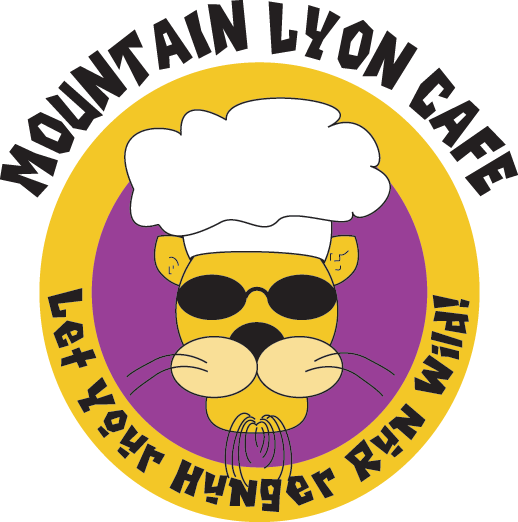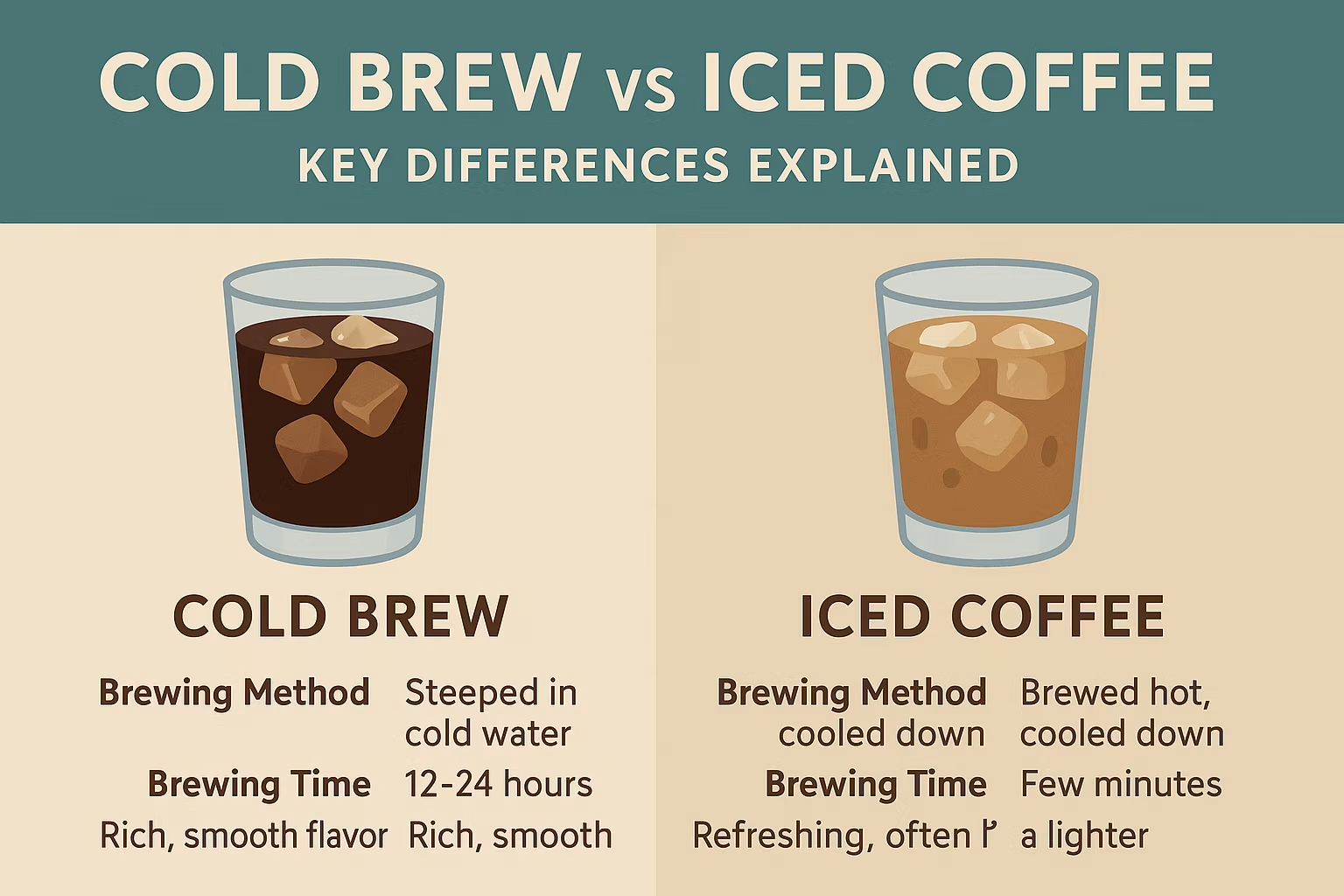Curious about the difference between cold brew vs iced coffee? Learn how brewing methods, flavor, caffeine levels, and culture set them apart. Our detailed guide explains everything so you can choose the perfect chilled coffee for summer.
Cold Brew vs Iced Coffee: Key Differences Explained
When summer arrives and the heat makes a steaming hot cappuccino less appealing, many coffee lovers turn to chilled options. But have you ever wondered about the difference between cold brew and iced coffee? While both are refreshing, they are not the same.
Their brewing methods, flavor profiles, caffeine content, and cultural histories make them distinct. Choosing between them isn’t just about temperature; it’s about understanding the craft behind each style.
What Is the Difference Between Cold Brew and Iced Coffee?
At the core, the main difference between cold brew and iced coffee is in the way they are made. Cold brew is brewed cold, iced coffee is brewed hot. Yet this distinction has ripple effects on taste, texture, caffeine, and even shelf life.
Brewing Method: Steeping vs. Hot Brewing Over Ice
Cold Brew: Made by steeping coarse coffee grounds in cold water for 12–24 hours. The result is a coffee concentrate that is diluted with water or milk before serving. The long extraction emphasizes smoothness and low acidity.
Iced Coffee: Traditionally brewed hot using drip, pour-over, or espresso, then cooled and served over ice. The hot extraction highlights brightness and acidity, resulting in a lively, refreshing drink.
| Brewing Style | Cold Brew | Iced Coffee |
|---|---|---|
| Water Temp | Cold/room temp | Hot (195–205°F) |
| Time | 12–24 hours | Minutes |
| Grind | Coarse | Medium to fine |
| Result | Smooth, mellow concentrate | Bright, aromatic coffee |
Barista Insight: “Cold brew is about patience, iced coffee is about immediacy. Both honor coffee beans in different ways.”
Flavor Profile: Smooth vs. Bright and Refreshing
Cold Brew: Tends to taste smooth, chocolaty, nutty, and sweet, with reduced bitterness and acidity. Perfect for those who like gentler flavors or add-ins like cream, oat milk, or vanilla syrup.
Iced Coffee: Retains the bean’s natural acidity, offering a crisper, fruitier, and brighter flavor. Fans of pour-over and specialty single-origin coffees often prefer iced coffee for its complexity.
A 2023 Specialty Coffee Association survey found that 62% of U.S. coffee drinkers associate cold brew with smoothness, while 58% associate iced coffee with refreshment and brightness.
Caffeine Levels and Health Considerations
Cold brew is often marketed as stronger, but the truth depends on how it’s served:
Cold Brew Concentrate: Extremely high in caffeine—up to 200 mg per 8 oz serving before dilution.
Diluted Cold Brew: Typically around 150 mg per 12 oz cup.
Iced Coffee: Usually 90–120 mg per 12 oz cup, depending on brew strength.
Health-conscious consumers also compare calories. Cold brew, often served with milk or cream, may have more calories than black iced coffee. But both can be as healthy as you want them to be depending on preparation.
History and Origins of Cold Brew and Iced Coffee
Understanding the origins of cold brew and iced coffee reveals how culture shaped their identities.
Japanese-Style Iced Coffee Tradition
Iced coffee has deep roots in Japan, where the method of brewing hot coffee directly over ice was perfected. Known as the Japanese iced coffee method, it preserves volatile aromatics while instantly cooling the beverage, ensuring a crisp, aromatic cup. Japanese iced coffee rose to popularity in the 1960s, long before it appeared on American café menus.
Cold Brew’s Rise in the U.S. Specialty Coffee Scene
Cold brew, although associated with modern third wave coffee, actually dates back centuries. Records from the 1600s show Dutch traders making cold-steeped coffee to preserve it on long voyages, later influencing Kyoto-style slow-drip towers.
In the U.S., cold brew’s explosion came in the 2010s, when brands like Starbucks, Stumptown, and Blue Bottle introduced bottled cold brew and made it mainstream. By 2024, Statista reported that cold brew sales in the U.S. exceeded $1.5 billion annually, proving its dominance as more than just a trend.
Taste Comparison: Which One Should You Choose?
Now that we know how they are made and where they come from, let’s compare cold brew vs iced coffee taste side by side.
Acidity, Body, and Sweetness Differences
Cold Brew: Low acidity, heavy body, mellow sweetness. Works well with chocolate desserts or creamy breakfast pastries.
Iced Coffee: Higher acidity, lighter body, brighter taste. Pairs beautifully with fruit-based pastries like croissants or berry tarts.
| Taste Factor | Cold Brew | Iced Coffee |
|---|---|---|
| Acidity | Low | Medium–High |
| Body | Full, syrupy | Light–medium |
| Sweetness | Naturally sweeter | Less sweet, more crisp |
| Best Pairings | Chocolate, cream, vanilla | Citrus, fruits, light pastries |
Best Pairings with Milk, Cream, and Flavors
Cold Brew: A natural partner to milk alternatives and syrups. Vanilla cold brew and nitro cold brew are favorites at Starbucks.
Iced Coffee: Works best with minimal add-ins to highlight its refreshing qualities. A splash of milk or a dash of sugar keeps it lively without masking origin flavors.
Proverb: “Tell me how you drink your coffee, and I’ll tell you who you are.” Cold brew fans are often patient, indulgent, and detail-oriented, while iced coffee lovers are spontaneous, lively, and adventurous.
Practical Differences in Preparation and Serving
Choosing between cold brew and iced coffee isn’t just about flavor—it’s also about time, cost, and convenience.
Brewing Time, Equipment, and Cost
Cold Brew: Requires a steeping vessel, coarse grounds, and 12–24 hours. More time-consuming but can be made in large batches.
Iced Coffee: Needs a standard coffee maker, pour-over, or espresso machine, plus ice. Ready in minutes, making it more convenient for daily routines.
From a cost perspective, cold brew requires more beans (often twice the amount), making it more expensive per cup, while iced coffee is more economical.
Shelf Life and Storage Tips
Cold Brew: Keeps well in the fridge for up to a week, thanks to low acidity. Great for preparing a batch in advance.
Iced Coffee: Best consumed immediately. Leftover iced coffee often turns stale and bitter within hours.
This difference is one of practicality: cold brew is ideal for planners, iced coffee for those who enjoy spontaneity.
Cultural and Lifestyle Aspects
The story of the difference between cold brew and iced coffee is not only technical—it is cultural. Around the world, how we brew chilled coffee reflects local traditions, lifestyles, and even business trends.
Why Cold Brew Became a Starbucks Favorite
Cold brew’s global fame skyrocketed when Starbucks introduced it to their U.S. menus in 2015. With smooth texture and lower acidity, it appealed to a younger demographic seeking innovation in coffee. Soon after, nitro cold brew, infused with nitrogen for a creamy head, became a premium offering.
By 2024, Starbucks reported that cold brew sales had grown at double-digit rates year over year, outpacing many other beverages on their menu. This corporate push turned cold brew from a niche specialty into a mainstream staple.
Seasonal Preferences: Summer Coffee Culture
In summer, cafés from Los Angeles to Tokyo compete with creative cold coffee variations. Cold brew dominates with flavored versions—vanilla, caramel, pumpkin spice—while iced coffee continues as a more traditional choice, especially in regions like Japan where it has cultural roots.
In Italy, iced espresso (shakerato) reigns supreme, while in the U.S. West Coast, cold brew has become the “coffee of summer.” This reflects how lifestyle and climate influence preference: iced coffee for quick refreshment, cold brew for indulgence and innovation.
Read more: How to Choose the Best Coffee Beans for Espresso
Tips for Making Cold Brew and Iced Coffee at Home
Knowing the difference between cold brew and iced coffee empowers you to make them yourself. With the right method, you can replicate café-quality beverages without leaving your kitchen.
Step-by-Step Guide to Cold Brew Concentrate
Measure: Use a ratio of 1 cup coarse ground coffee to 4 cups cold, filtered water.
Steep: Place in a jar or French press, cover, and let steep at room temperature or in the fridge for 12–24 hours.
Strain: Filter through a fine mesh sieve or cheesecloth to remove grounds.
Dilute: Mix concentrate with equal parts water, milk, or alternative milk.
Serve: Pour over ice, add flavorings if desired, and enjoy.
How to Brew Iced Coffee with the Japanese Method
Measure: Use a ratio of 1 part hot coffee to 1 part ice.
Brew: Brew coffee hot using pour-over (V60 or Chemex), dripping directly over ice to cool instantly.
Serve: Stir, adjust sweetness or milk, and drink immediately.
Expert Tip from Baristas: Cold brew is perfect for batch preparation—you can store a week’s worth in your fridge. Iced coffee, however, should be enjoyed fresh for maximum brightness and aroma.
Evidence, Analysis, and Benefits
Choosing between cold brew and iced coffee depends on analyzing not just taste, but practical and health factors.
Credibility: Scientific studies show cold brew has lower perceived acidity, making it gentler for sensitive stomachs. UC Davis research in 2022 demonstrated that hot-brewed coffee retains higher antioxidant levels, offering potential health benefits.
Authority: Brands like Blue Bottle and Stumptown pioneered cold brew in California, while traditional Japanese roasters like Hario promote iced coffee brewing globally. Their expertise legitimizes both methods.
Analysis: Cold brew requires more coffee grounds, making it pricier per serving. Iced coffee is faster and cheaper, but lacks the longevity of cold brew concentrate.
Benefits: Cold brew suits those who want smoother, less acidic coffee with higher caffeine and convenience of batch brewing. Iced coffee appeals to those who enjoy lively, crisp flavors and quick preparation.
Inspiration and Storytelling
Coffee is never just about caffeine—it is about memory, culture, and experience. A college student may remember late nights fueled by cold brew during exams. A traveler in Kyoto may recall sipping delicate iced coffee brewed over ice with precision and grace.
At Lyoncafe, we have witnessed how customers from different backgrounds connect with coffee differently—some seeking energy, others seeking comfort. As the proverb says, “Coffee and love taste best when hot, but memories linger even when cold.” This poetic truth explains why cold coffee drinks, whether cold brew or iced coffee, hold a special place in modern life.
Conclusion: Understanding the Difference Between Cold Brew and Iced Coffee
In the end, the difference between cold brew and iced coffee lies in more than method. Cold brew is patient, smooth, and indulgent—perfect for planners, dreamers, and those who savor calm. Iced coffee is immediate, bright, and refreshing—ideal for people on the move who embrace spontaneity. Both are pillars of modern coffee culture, shaped by history, science, and innovation.

My name is Kara Chavez, and I love coffee. I love making the best coffees – espresso, latte, macchiato. I always strive for perfection in my barista skills, and I take great pride in bringing delicious cups of coffee to my customers.
I’ve been in the coffee industry for many years, and I know everything there is to know about brewing the perfect cup of coffee. My passion for coffee shines through in every cup I make, and I hope you’ll stop by soon so I can share my love of coffee with you!

